Kingdom Animalia Genus Plectropomus Higher classification Plectropomus Rank Species | Family Serranidae Scientific name Plectropomus leopardus Phylum Chordata Order Perciformes | |
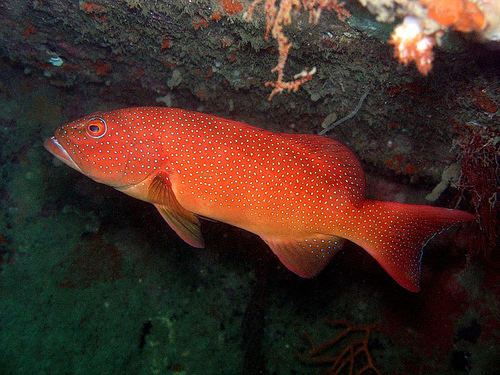 | ||
Similar Plectropomus, Orange‑spotted grouper, Humpback grouper, Greasy grouper, Grouper | ||
Gopro coral trout fishing on the great barrier reef norlaus ep3
The coral trout, leopard coral grouper, or leopard coral trout (Plectropomus leopardus) is a species of fish in the Serranidae family. Native to the western Pacific Ocean, its natural habitat includes open seas and coral reefs. Coral trout are piscivorous; juveniles mostly eat crustaceans, especially prawns, and adults feed upon a variety of reef fish, particularly damselfish.
Contents
- Gopro coral trout fishing on the great barrier reef norlaus ep3
- Coral trout fishing on shallow bommies
- Taxonomy
- Distribution and habitat
- Reproduction
- Spawning
- Courtship
- Spawning rush
- Larvae
- Growth and lifespan
- Diet
- References
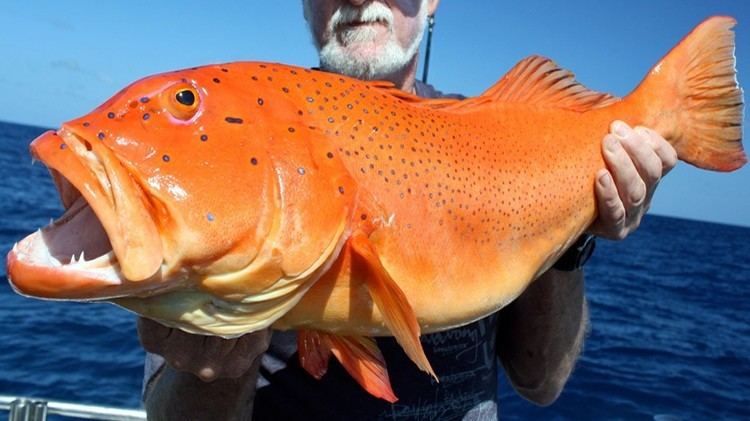
Coral trout are the favourite target fish for all sectors of the fishery because they are a good food fish and command high market prices locally and overseas. The total commercial catch of coral trout was reported at over 1500 tonnes in 1998.
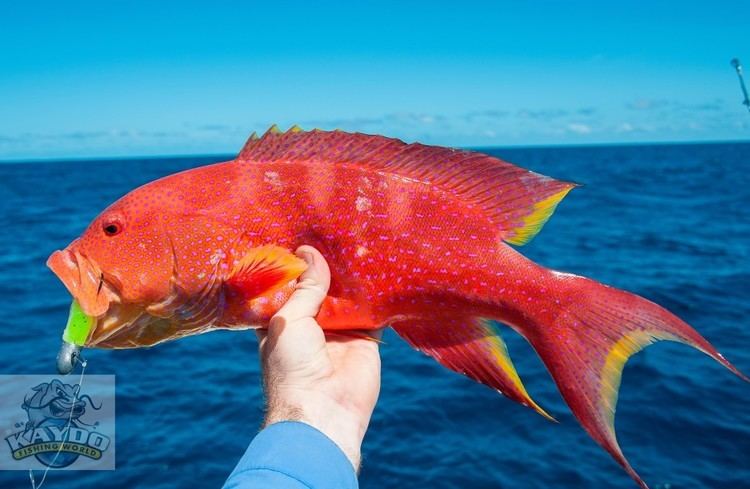
Coral trout fishing on shallow bommies
Taxonomy
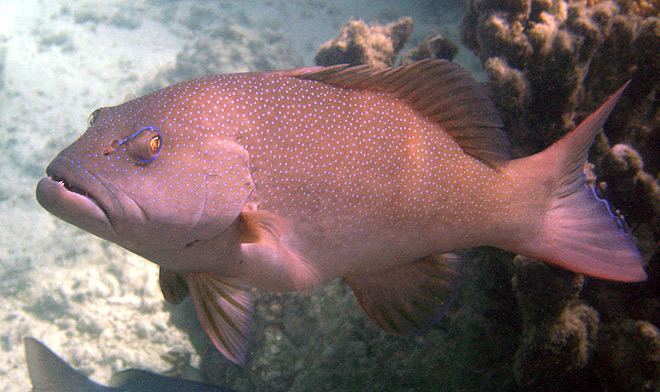
Initially described by French naturalist Bernard Germain de Lacépède in 1802, the Coral trout belongs to a family of fish known as the Serranidae. This family includes groupers and coral cod (not related to true cod), which are all characterised by having three spines on the gill cover and a large mouth lined with more than one row of sharp teeth.
Distribution and habitat

The Coral trout is found in the waters around American Samoa, Australia, Brunei, Cocos (Keeling) Islands, Fiji, Hong Kong, Indonesia, Japan, Malaysia, Micronesia, New Caledonia, Northern Mariana Islands, Palau, Papua New Guinea, the Philippines, Samoa, Singapore, Solomon Islands, Taiwan, Thailand, Vietnam, Saudi Arabia, and Egypt . Its natural habitat includes open seas and coral reefs. Studies suggest that coral trout move around considerably within a single reef, though often no further than 500 meters (1,600 ft) from it. Movement between neighbouring reefs does not occur to a large extent; however, there have been a few cases where fish have moved from one reef to another. Much of this movement may be the result of fish moving towards or away from spawning sites.
Reproduction
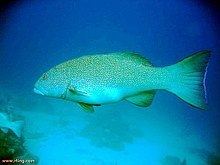
Documenting the size and age structures during reproduction of coral trout stocks have been a focus of the ELF Experiment as a major indication of how fish stocks respond to various levels of fishing pressure.
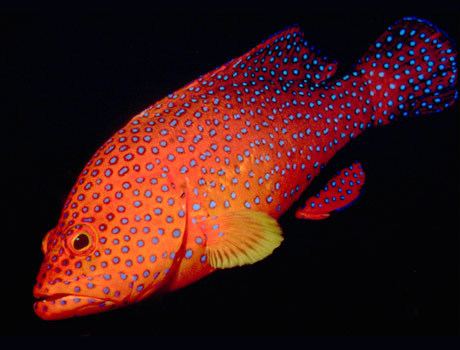
Coral trout are protogynous hermaphrodites. They start their lives as females and change sex later in life. The trigger of this sex change is unknown. On average, sex change occurs when fish are between 23 centimetres (9.1 in) and 62 cm (24 in) in length; the average length at sex change is 42 centimetres (17 in). This is believed to happen most frequently in the months immediately following spawning.
ELF research has determined that the sex ratio differs in different areas of the Great Barrier Reef, and may differ between reefs opened and protected from fishing. Sex ratios are an important consideration for management, as changes could seriously affect reproduction and thus the number of juveniles coming into the fishery in future years. All length classes of fish may have both male and female individuals. However, small fish are generally females, while most large fish are males.
Spawning
Like many fish, coral trout spawning corresponds to an increase in water temperature (from 25.0 to 26.5 °C or 77.0 to 79.7 °F) during late spring. In the northern Great Barrier Reef, coral trout spawn between September and December, whereas in the southern regions where the water is cooler, spawning occurs between October and February. The beginning and end of spawning can vary from year to year as the water temperature varies.
Coral trout generally aggregate (crowd into a dense cluster) to spawn. These aggregations are formed around reef slopes around 10 to 15 meters (33 to 49 ft) deep and peak at the new moon. Spawning occurs when the tidal flow is strong, particularly during ebb tides. This is thought to allow the newly released eggs to be transported well away from the reef and its associated predators. Spawning typically takes place at dusk, when the light levels make it difficult for predators to see and feed upon the eggs.
Courtship
As coral trout aggregate, males establish temporary territories. They then try to entice females into their territories to spawn by means of elaborate courtship displays. As part of this courtship ritual, male coral trout display their fins' darkened edges, which can be switched on and off almost instantly. The male will approach a female, which is usually close to the bottom, with his body tilted at 45°–90° (almost lying on his side in the water) and repeatedly quivering lengthwise and shaking his head from side to side. He passes close to the female's head or body with either the top or underside of his body. This process is repeated.
Spawning rush
Spawning rushes occur after this courtship behaviour, if the female agrees. During a spawning rush, the male and female swim rapidly towards the surface, where they release sperm and eggs into the water as they quickly turn. The cloud of sperm and eggs released during a spawning rush is not easily seen, but its presence can sometimes be noted by the frantic feeding of small plankton-eating fish.
The spawning of coral trout generally occurs over a 30-40 minute period during sunset. Some coral trout (especially males) spawn more than once during an evening.
Larvae
Like most reef fish, coral trout have a larval stage where the eggs and larvae develop within the water column, allowing them to disperse to nearby reefs.
Fertilisation takes place after spawning; the fertilised eggs float just below the water surface. The incubation period for coral trout eggs is unknown, but may be around 20 to 45 hours (the incubation period in related species). The newly hatched larvae are not very well developed and obtain nutrients from a yolk sac. As the develop, their spines, fins, gut, and other internal organs develop, as do their senses. Eventually, the yolk sac is completely absorbed and the larvae begin to see and catch their own prey.
Growth and lifespan
The fastest period of growth in coral trout occurs in the first three years of life. The average daily growth of newly settled juveniles has been measured at 0.81 mm per day. This means they reach close to 14 cm (5.5 in) in the first 6 months.
Growth rates of coral trout are variable; every age class has a wide range of sizes. To estimate growth, the age and size of a fish must be determined. Most commonly, the growth of fish is measured by collecting individuals of varying sizes, measuring their length and determining their age by the otoliths.
Recent research at Bramble Reef has found that common coral trout (P. leopardus) reaches a maximum age of 16 years.
Diet
Coral trout are piscivores (fish-eating predators). Younger juvenile trout mostly eat crustaceans, especially prawns which live on or near the reef bottom. However, adults feed upon a variety of reef fish. The most common type of fish eaten is damselfish (family Pomacentridae), particularly the spiny chromis damselfish (Acanthochromis polyacanthus). Adult coral trout also eat juveniles of their own species. Individual coral trout usually feed once every 1–3 days, although they may go for many days without feeding. 90% of a prey item will be digested within 24 hours. Coral trout only feed during daylight hours, most often at dusk and dawn.
Coral trout hunt in two different ways: by ambush and by prowling. They use the ambush method to hunt fish that live among the coral on the reef bottom. The trout will hide and remain very still and alert, ready to attack passing prey. The prowling method is used to hunt schooling fish higher up in the water. Here, the trout will move (prowl) slowly towards the prey and attack at great speed.
Individual coral trout have different feeding behaviours, possibly explaining the variability in growth and maturity.
Studies have shown that coral trout in the southern Great Barrier Reef feed mainly on parrot fish (family Scaridae) and hardyhead bait fish (family Atherinidae). The most common prey items further north are the damselfish (Pomacentridae) and fusiliers or banana fish (Caesionidae). One study showed coral trout eating schools of fusilers in summer, and scarids during the winter months. This seasonal variation is quite common in the diet of coral trout due to varying abundances of prey at different times of the year. Trout also tend to eat more food in winter, possibly to increase fat stores in preparation for reproduction in spring.
Harvest
Queensland, Australia has a significant coral trout fishery. Fishermen catch the trout using hand lines and pilchards for bait, operating from small dories or runabouts throughout the day then returning to a mother ship where the catch is kept live in bio tanks until the return to Port after several days working at sea.
